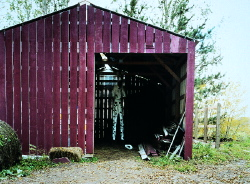Chris Larson
Rare, New York, USA
Rare, New York, USA

If the protagonists of Matthew Barney's 'Cremaster' cycle had a set of country cousins from the backwoods, they might look and behave something like The Man in Black, The Golden Overall-Wearing Farmer and The Long-Legged, Golden-Toothed, Fancy-Suited Country & Western Honky Tonk and Gospel Singer. The performers of a travelling vaudeville show titled 'Saturday Night, Sunday Morning', this sinister trio act out their enigmatic drama before Minnesota-based artist Chris Larson's camera and an audience that we can only hope includes no children. Because while they indulge in neither sex nor violence, the stars of his short film Bogus Brook Township (Saturday Night, Sunday Morning) (2001) combine charisma with menace in the style of the crooked preacher played by Robert Mitchum in Charles Laughton's The Night of the Hunter (1955). Would you like me to tell you the little story of right hand, left hand? The story of good and evil?
To a woozy soundtrack that suggests Eraserhead (1976) but was in fact sound designer Alan Splet performing forgotten bluegrass numbers, an unsettling narrative unfolds. The Man in Black (a.k.a. Mr Saturday Night) opens the show by using his home-made turntable to mix doses of black and white liquid into a single spinning disc that looks rather like a Bakewell tart. He then prepares a 'metamorphosis birthing bed' by hooking up a pump to a large sack sitting on a table, which he proceeds to fill with air. At this point The Golden Overall-Wearing Farmer (a.k.a. Mr Sunday Morning) emerges from a pool of water to perform his own version of The Man in Black's routine. At the climax of the show The Long-Legged, Golden-Toothed, Fancy-Suited Country & Western Honky Tonk and Gospel Singer (a.k.a. Mr Saturday Night, Sunday Morning) bursts out of the sack. Rendered immobile by his absurdly elongated limbs, and speechless by his glinting, oversized dentures (how is it that Goldie never has this problem?), the mutant offspring can do nothing but grin hideously as the film fades to black.
A series of large colour photographs follow the characters further - in the case of The Farmer and The Long-Legged Man to their ends, with one floating face down in the river, the other hanging in a barn. Only The Man in Black survives, continuing his attempts at self-transformation by struggling with The Long-Legged Man's stilts and a cadre of other, increasingly complicated but equally unsuccessful, wooden contraptions. Appearing both functional and fabulously eccentric, these fuse Heath Robinson ropes-and-pulleys malarkey with the darker, fetishistic edge of the custom-made surgical instruments from David Cronenberg's Dead Ringers (1988) or the tortuously awkward sex-on-crutches-in-the-driver's-seat scene in Crash (1999). They also look appropriately folksy and hand-crafted, a detail borne out by Untitled (Bogus Brook Sculpture) (2002), an engine part modelled in whittled oak and wax paper.
Larson describes his self-consciously fantastic American Gothicism using quasi-biblical terminology, making frequent reference to good and evil, nobility and sin. So The Long-Legged Man represents a perversion of the ideal blend of love and hate for which The Man in Black perpetually aims, while The Farmer symbolizes virtue achieved through harmony with nature. But rather than expecting to garner any great wisdom from these fragments of parable, we would do better to treat them as individual elements in a broader mythology, and one that is still very much a work in progress. They establish structure and mood, but remain secondary to the artist's formal style. Larson's decision to display the three outfits worn by his characters is a logical one, but these too fall slightly short. The paint is too opaque and the clothes look too new and rigid to convince as the relics of actual use. Like costumes left over from a school play, they look silly and a bit sad mounted preciously on the gallery wall.
Larson is in the unfortunate but not hopeless position of one whose ambition, for the time being, exceeds his ability. The fact that his work brings that of so many others so readily to mind (did I mention Czech master animator Jan Svankmajer or Wisconsin Death Trip compiler Michael Lesy?) makes the suspension of disbelief a difficult task. The alternate fin-de-siècle world that his characters inhabit is certainly rich and potentially fascinating, but his partial exploration of it is, for now, as frustrating as it is intriguing. The fact that Bogus Brook Township (Saturday Night, Sunday Morning) is confined to Rare's cramped alcove rather than projected in its main space suggests a certain lack of confidence that the artist, or gallery, should by now have overcome. Larson's is a dish of rich ingredients, but it tastes like it needs just a little longer in the oven.
















